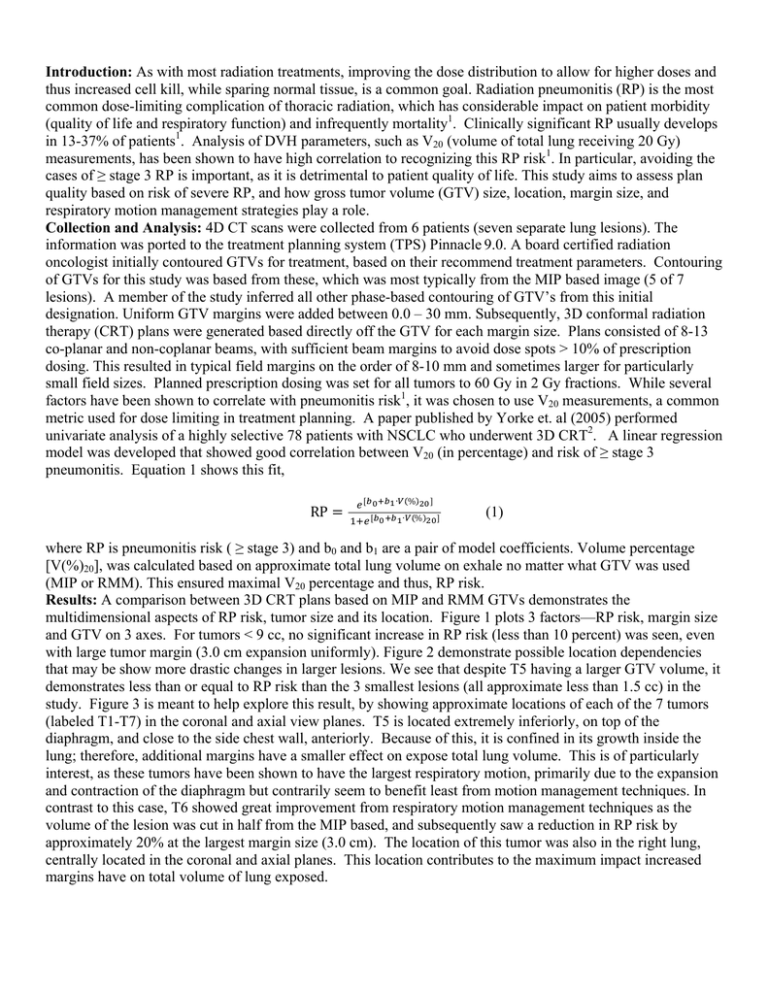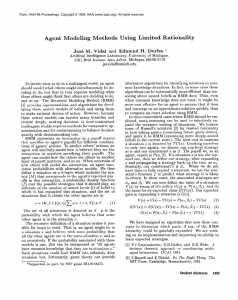
Introduction: As with most radiation treatments, improving the dose distribution to allow for higher doses and
thus increased cell kill, while sparing normal tissue, is a common goal. Radiation pneumonitis (RP) is the most
common dose-limiting complication of thoracic radiation, which has considerable impact on patient morbidity
(quality of life and respiratory function) and infrequently mortality1. Clinically significant RP usually develops
in 13-37% of patients1. Analysis of DVH parameters, such as V20 (volume of total lung receiving 20 Gy)
measurements, has been shown to have high correlation to recognizing this RP risk1. In particular, avoiding the
cases of ≥ stage 3 RP is important, as it is detrimental to patient quality of life. This study aims to assess plan
quality based on risk of severe RP, and how gross tumor volume (GTV) size, location, margin size, and
respiratory motion management strategies play a role.
Collection and Analysis: 4D CT scans were collected from 6 patients (seven separate lung lesions). The
information was ported to the treatment planning system (TPS) Pinnacle 9.0. A board certified radiation
oncologist initially contoured GTVs for treatment, based on their recommend treatment parameters. Contouring
of GTVs for this study was based from these, which was most typically from the MIP based image (5 of 7
lesions). A member of the study inferred all other phase-based contouring of GTV’s from this initial
designation. Uniform GTV margins were added between 0.0 – 30 mm. Subsequently, 3D conformal radiation
therapy (CRT) plans were generated based directly off the GTV for each margin size. Plans consisted of 8-13
co-planar and non-coplanar beams, with sufficient beam margins to avoid dose spots > 10% of prescription
dosing. This resulted in typical field margins on the order of 8-10 mm and sometimes larger for particularly
small field sizes. Planned prescription dosing was set for all tumors to 60 Gy in 2 Gy fractions. While several
factors have been shown to correlate with pneumonitis risk1, it was chosen to use V20 measurements, a common
metric used for dose limiting in treatment planning. A paper published by Yorke et. al (2005) performed
univariate analysis of a highly selective 78 patients with NSCLC who underwent 3D CRT2. A linear regression
model was developed that showed good correlation between V20 (in percentage) and risk of ≥ stage 3
pneumonitis. Equation 1 shows this fit,
! [!! !!! ∙! % !" ]
RP = !!! [!!!!!∙! % !"]
(1)
where RP is pneumonitis risk ( ≥ stage 3) and b0 and b1 are a pair of model coefficients. Volume percentage
[V(%)20], was calculated based on approximate total lung volume on exhale no matter what GTV was used
(MIP or RMM). This ensured maximal V20 percentage and thus, RP risk.
Results: A comparison between 3D CRT plans based on MIP and RMM GTVs demonstrates the
multidimensional aspects of RP risk, tumor size and its location. Figure 1 plots 3 factors—RP risk, margin size
and GTV on 3 axes. For tumors < 9 cc, no significant increase in RP risk (less than 10 percent) was seen, even
with large tumor margin (3.0 cm expansion uniformly). Figure 2 demonstrate possible location dependencies
that may be show more drastic changes in larger lesions. We see that despite T5 having a larger GTV volume, it
demonstrates less than or equal to RP risk than the 3 smallest lesions (all approximate less than 1.5 cc) in the
study. Figure 3 is meant to help explore this result, by showing approximate locations of each of the 7 tumors
(labeled T1-T7) in the coronal and axial view planes. T5 is located extremely inferiorly, on top of the
diaphragm, and close to the side chest wall, anteriorly. Because of this, it is confined in its growth inside the
lung; therefore, additional margins have a smaller effect on expose total lung volume. This is of particularly
interest, as these tumors have been shown to have the largest respiratory motion, primarily due to the expansion
and contraction of the diaphragm but contrarily seem to benefit least from motion management techniques. In
contrast to this case, T6 showed great improvement from respiratory motion management techniques as the
volume of the lesion was cut in half from the MIP based, and subsequently saw a reduction in RP risk by
approximately 20% at the largest margin size (3.0 cm). The location of this tumor was also in the right lung,
centrally located in the coronal and axial planes. This location contributes to the maximum impact increased
margins have on total volume of lung exposed.
T1
T1 RMM
T2
T3
T4
T5
T5 RMM
T6
T6 RMM
T7
T7 RMM
Risk of >= Stage 3 RP Probability (%)
35
14
30
25
20
15
10
5
12
10
8
6
4
30
20
0
60
T1 RMM
T2
T3
T4
T5
T5 RMM
T6 RMM
16
Risk of >= Stage 3 RP Probability (%)
40
50
40
30
20
10
0
0
2
10
Uniform Margin Size (mm)
[ PTV = GTV + Margin]
12
GTV (cc)
10
8
6
4
2
GTV (cc)
FIGURE 1. Three dimensional plot showing relationship
between RP risk ( ≥ stage 3), GTV margin and size. This
combines all GTV’s based upon MIP and RMM (single
phase) contouring. 0
0
30
20
10
Uniform Margin Size (mm)
[ PTV = GTV + Margin ]
FIGURE 2. Three dimensional plot showing relationship between RP
risk ( ≥ stage 3), GTV margin and size. This combines GTV’s based
upon MIP and RMM (single phase) contouring and is a close up of
Figure 1. FIGURE 3. Schematic to facilitate approximate location of 7 tumors under study3. TABLE 1. Summary of Data Collected. *Full 4D CT Scans were not available for this data
Tumor #
MIP Tumor Size (cc)
RMM Tumor Size (cc)
Lung Size (cc)
1
2
3
4
5
6
7
14.1
1.15
1.36
1.07
5.16
30.56
56.86
7.6
N/A
N/A
N/A*
4.94
12.35
43.3
3695.4
2174.6
2174.6
3861.1
3574.9
2786.8
3944.6
Tumor Motion (cm)
(Sup-Inf)
1.39
1.69
0.12
N/A*
N/A
0.97
0.43
References
1
Rodrigues G, et al. "Prediction of Radiation Pneumonitis by Dose - Volume Histogram Parameters in Lung Cancer--a Systematic Review."
Radiotherapy and oncology : journal of the European Society for Therapeutic Radiology and Oncology 71.2 (2004): 127-38. Print.
2
Yorke, Ellen D., et al. "Correlation of Dosimetric Factors and Radiation Pneumonitis for Non-Small-Cell Lung Cancer Patients in a Recently
Completed Dose Escalation Study." International Journal of Radiation Oncology, Biology and Physics 63.3 (2005): 672-82. Print.
3
Figure adapted from image developed by Copyright © Julia A. Stack 2011. All rights reserved







